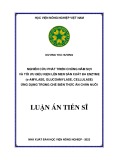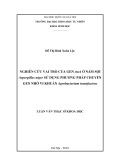
JST: Engineering and Technology for Sustainable Development
Volume 35, Issue 1, March 2025, 017-023
17
Investigation of the Antifungal Activity of Lactobacillus against
Aspergillus Niger and Penicillium Oxalicum
Nguyen Hai Van, Nguyen Ba Thu Uyen, Dang Thi Phuong Thao, Nguyen Tien Cuong*
School of Chemistry and Life Sciences, Hanoi University of Science and Technology, Ha Noi, Vietnam
*Corresponding author email: cuong.nguyentien1@hust.edu.vn
Abstract
The study investigated the antifungal activity against Aspergillus niger CBS 76997 and Penicillium oxalicum
20B of several Lactobacillus strains (LAB). The in vitro antifungal activity of cell-free supernatants and biomass
of Lactobacillus strains against the growth of A. niger CBS 76997 and P. oxalicum 20B was determined by
monitoring the fungal colony diameter over time by spot inoculation method and double layer method. The
antifungal effect was dependent on LAB and fungi strains. The control sample of A. niger and P. oxalicum
reached the mycelial growth diameter 100% (85 mm) after 5 days and 10 days, respectively. The cell-free
supernatant and biomass of LAB could inhibit the growth of tested fungi ranging from 35.3% to 84.7% and
from 30.6 to 100%, respectively. When inoculation, LAB can delay the spore-forming process from 2 to
10 days. The research results demonstrated the potential application of lactic acid bacteria as a biological
inhibitor of fungal growth in the preservation and processing of food products.
Keywords: Aspergillus Niger, antifungal activity, lactic acid bacteria, Penicillium oxalicum.
1. Introduction*
Fungi are generally found in soil, air, and plants
and can contaminate a variety of foods and animal
feeds. Aspergillus and Penicillium are very important
spoilage in food. It is known commonly to cause black
mold in fruits and vegetables like grapes, apricots,
onions, and peanuts, leading to food contamination or
spoilage. According to a report by the Food and
Agriculture Organization of the United Nations
(FAO), hundreds of billions of dollars are lost across
the world each year due to fungal and toxin infestation
of crops, resulting in loss of food value and consequent
significant economic losses [1]. Around 931 tons/year
of food was estimated to be wasted globally, with fungi
spoilage being the main reason. In addition, fungi are
capable of producing a mycotoxin (aflatoxins,
ochratoxins, trichothecenes, zearalenone, fumonisins,
and patulin), considered a public health concern which
is associated with both toxicity and carcinogenicity.
Despite enormous investments in crop
production, technological preservation in the harvest
and post-harvest stages remains lacking. Some
physical and chemical preservatives have been applied
to control fungi growth. Washing and drying are
commonly used in cereal storage, but they are low in
efficiency since they can only remove a small
percentage of mould and mycotoxins. As a control tool
for fungal growth, food industries react by adopting
good manufacturing practices and generally using
ISSN 2734-9381
https://doi.org/10.51316/jst.180.etsd.2025.35.1.3
Received: Jul 30, 2024; revised: Oct 7, 2024;
accepted: Oct 30, 2024
chemical preservatives such as natamycin, sulfite,
potassium sorbate or sodium benzoate. However,
major drawbacks of chemical preservation methods
are the requirements of precise pressure and
temperature controls and the chemical residues in
post-treatment food products, making them technically
difficult and costly to implement in practice [2].
Among many alternative bioactive natural
antifungal compounds proposed to date, lactic acid
bacteria have become a new trend of interest recently.
Lactic acid bacteria (LAB), recognized as a safe and
qualified additive by the Food and Drug
Administration (FDA), have been shown to inhibit
fungal growth and degrade mycotoxins [3]. LAB could
inhibit fungal spore germination and mycelial growth
by competing for growth space and by secreting
nutrient-rich microbial active substances. Antifungal
LAB produces active metabolites such as lactic acid,
acetic acid, cyclic dipeptides, phenylacetic acid,
hydroxy fatty acids, and 3-hydroxy propionaldehyde,
which have been shown to be associated with the
antifungal effect of LAB [3]. Some LAB strains have
demonstrated antimicrobial activity from producing
antimicrobial compounds that can be used as natural
preservatives in a broad range of food products.
However, to the best of our knowledge, the research on
the antifungal effects of LAB in Vietnam was limited.
Hence, the objective of this study was to
investigate fungal inhibition of some LAB. The aim is

























